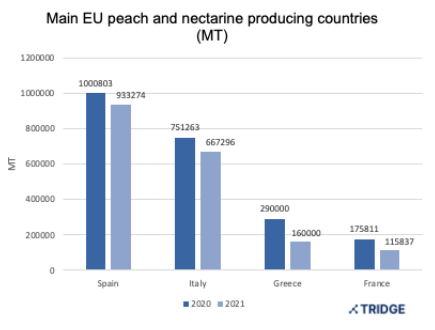EU faces the smallest crop of peaches and nectarines in 30 years

The EU is leading the global peach and nectarine production in the world, with the main producers like Spain, Italy, Greece, and France. In 2021, the global production of peach and nectarines is expected to be 15% smaller than the previous year, reaching record low levels in 30 years. As the 2020 production was also lower than average, production decrease further aggravated the available amount of peaches and nectarines in Europe. This situation occurred by the combination of two factors: the reduction of planted area and the unfavorable weather conditions. The reduction in the planted area occurred due to the overharvesting seen in recent years, which eventually caused less soil fertility of peach and nectarine orchard. This caused prices to crash and farmers to drop production or switch their peach and nectarine orchards to other crops, resulting in a reduction of production. On top of this, frosts and hail repeatedly occurred during this March and April, affecting the yield in all producing areas of Europe, with the most significant percentage decreases in Greece and France.

Source: Tridge, ITC
Outside the main producing countries, the EU shall see a reduced availability of peaches and nectarines this year. The largest wholesalers are looking into Morocco and Tunisia to fill the production shortage in the European country’s gap. Some Moroccan farmers already eye the EU market with the news of frosts as a golden opportunity. In 2020, the Moroccan exports of agricultural products to the EU had already increased by 9%, reaching 1.5 million MT, where nearly half of the volume was made out of fruits. For this year, the Moroccan producers expect to have an even better result.
Tunisia also expects an increase in stone fruits production by 7% compared to last year and expects to export 33.3% of this volume. The peaches and nectarines alone represent 53.5% of the total stone fruit production. The main destination country of Tunisian fruits was Libya, accounting for about 70% of total fruit exports. However, the pandemic has limited the land and air freight between countries, impacting the exports of peaches and apricots. With the reduction of exports to Libya, Tunisia will be able to supply the European market in 2021.
Turkey, one of the key suppliers of peaches and nectarines to the European market has seen a gradual increase in production recently, to meet the increasing demand. For this year, the production is expected to grow by 4.8% reaching 870 thousand MT, and can be an alternative source for supply of peaches and nectarines. The gradual increase in Turkish production will allow the exports to increase compared to previous year. As the majority of the Turkish stonefruits are destined to Russia, the European countries will need to hurry to secure some volumes.
Global decrease in peach and nectarine production
In 2021, a decrease in production is also observed in other countries as well, also due to the unfavorable weather conditions just like the European countries. The total decrease is expected to be by 5% reaching 21 million MT of production. China is the global leader in peach and nectarine production and will have a 3.3% decrease and causing a possible increase of imports by more than 40%. The US ranked sixth in peach and nectarine production, expects a volume comparable to 2017’s production and 3.6% less than the previous year, decreasing the exports to Mexico and Taiwan, their main markets. The Japanese peach and nectarines harvest runs from June to September and calculating by the damage caused by unusual rains at fruit growth the decrease will reach 9.3% compared to the previous year. Hong Kong, the main buyer of Japanese peaches and nectarines will possibly face prices higher than last year.
Source:
- AGMRC. The United States total peach production.
- Anba. "Tunisia aims to export 80000 tonnes of stone fruit”
- FreshPlaza. “Medfel publishes harvest estimates for European peaches and nectarines”
- FreshPlaza. “Reduced 2020-2021 pech and nectarine production globally due to bad weather”
- FreshPlaza. “EU peach and nectarine harvest down 15%”
- Morocco World News. “Moroccan farmers have a golden opportunity as frost sweeps EU”



